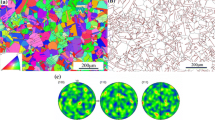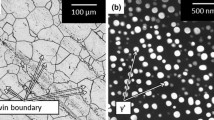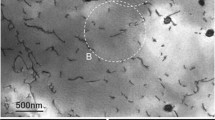Abstract
The fatigue behavior of the iron-base superalloy A-286 was studied at room temperature in air for three aging conditions: underaged, peak aged, and overaged. A fatigue strength at 107 cycles of about 200 MPa, independent of aging condition, was measured for an applied load ratio ofR =0.1. Surface crack initiation and propagation were measured using hourglass specimens. Surface cracks were invariably initiated in slip bands orientated between 45 and 55 deg to the load axis, and an average ratio of crack depth to crack length of about 0.45 for these semi-elliptical cracks was measured. These earliest observable short surface cracks grew at an accelerated propagation rate in the near-threshold regime but were retarded in a transition stage, resulting in a minimum in crack growth rate. This behavior was correlated to the interaction of the crack with specific microstructure features. Following this minimum, the crack growth accelerated again with increasing ΔK and appeared to converge with the crack growth behavior expected for long through cracks. The crack propagation rate at fixed ΔK was lowest in underaged, compared to peak aged and overaged microstructures. The minimum and trends in crack growth rate appeared to depend on the development of roughness-induced closure.
Similar content being viewed by others
References
S. Suresh and R. O. Ritchie:Int. Metals Reviews, 1984, vol. 29, pp. 445–76.
J. Lankford:Fatigue of Engineering Materials Structures, 1982, vol. 5, pp. 233–48.
C. Gerdes, A. Gysler, and G. Lütjering: inFatigue Crack Growth Threshold Concepts, D.L. Davidson and S. Suresh, eds., TMS- AIME, Warrendale, PA, 1984, pp. 465–78.
C. W. Brown and D. Taylor: inFatigue Crack Growth Threshold Concepts, D.L. Davidson and S. Suresh, eds., TMS-AIME, Warrendale, PA, 1984, pp. 433–66.
W. L. Morris and M. R. James: inFatigue Crack Growth Threshold Concepts, D.L. Davidson and S. Suresh, eds., TMS-AIME, Warrendale, PA, 1984, pp. 479–95.
R. F. Decker and S. Floreen: inPrecipitation from Iron-Base Alloys, Gordon and Breach, New York, NY, 1965, pp. 69–128.
D.R. Muzyka: inThe Superalloys, C.T. Sims and W. C. Hagel, eds., Wiley, New York, NY, 1972, pp. 113–43.
A. W. Thompson and J. A. Brooks:Metall. Trans A, 1975, vol. 6A, pp. 1431–42.
A.W. Thompson and J. A. Brooks:Acta Metall., 1982, vol. 30, pp. 2197–2203.
M.J. Blackburn and J.C. Williams:Trans. TMS-AIME, 1967, vol. 239, pp. 287–88.
D.C. Nguyen, A.W. Thompson, and I.M. Bernstein: unpublished research, Carnegie-Mellon, Pittsburgh, PA, 1985.
J. M. Silcock and N. T. Williams:J. Iron Steel Inst., 1966, vol. 204, pp. 1100–07.
F. G. Wilson and F. B. Pickering:Acta Metall., 1968, vol. 16, pp. 115–31.
D. Raynor and J. M. Silcock:Metal Sci. J., 1970, vol. 4, pp. 121–30.
F. G. Wilson: inEffect of Second-Phase Particles on the Mechanical Properties of Steel, Iron and Steel Inst., London, 1971, pp. 16–21.
J.F. Knott:Fundamentals of Fracture Mechanics, 2nd ed., Butter- worths, London, 1976, pp. 61–65.
J.C. Newman, Jr.: inPart-through Crack Fatigue Life Prediction, ASTM STP 687, J. B. Chang, ed., American Society for Testing and Materials, Philadelphia, PA, 1979, pp. 16–42.
C. Verpoort: Ph.D. Thesis, University of Bochum, W. Germany, 1980.
L. M. Brown and R. K. Ham: inStrengthening Methods in Crystals, A. Kelly and R.B. Nicholson, eds., Wiley, New York, NY, 1972, pp. 9–135.
L. K. Singhal and J.W. Martin:Acta Metall., 1968, vol. 16, pp. 947–53.
D.W. Worthem: Report No. 107, “Small Crack Growth in Biaxial Fatigue≓, UILU-ENG 84-3607, University of Illinois at Urbana- Champaign, IL, June 1984.
S. Suresh and R. O. Ritchie:Metall. Trans. A, 1982, vol. 13A, pp. 1627–31.
N. A. Fleck, I. F.'C. Smith, and R. A. Smith:Fatigue of Engineering Materials and Structures, 1983, vol. 6, pp. 225–39.
M. Jolies:Journal of Engineering Materials and Technology, 1983, vol. 105, pp. 215–18.
F. Erdogan and G.C. Sih:Trans. ASME, J. Bas. Eng., 1963, vol. 85, pp. 519–27.
W. K. Wilson: “On Combined Mode Fracture Mechanics≓, Report No. 69-1E7-F MECH-R1, Westinghouse Research Labs, 1969.
G.C. Sih: inMechanics of Fracture, G.C. Sih, ed., Noordhoff, Leiden, 1973, vol. 1.
A. P. Parker:The Mechanics of Fracture and Fatigue, 1st ed., E.&F.N. Spon Ltd., New York, NY, 1981, pp. 89–100.
K. Tanaka:Eng. Frac. Mech., 1974, vol. 6, pp. 443–507.
W. F. Brown and J. E. Srawley:Plane Strain Crack Toughness Test- ing of High Strength Metallic Alloys, ASTM STP 410, ASTM, Philadelphia, PA, 1966.
G.C. Sih:Handbook of Stress Intensity Factors for Researchers and Engineers, Institute of Fracture and Solid Mechanics, Lehigh Uni- versity, Bethlehem, PA, 1973.
R. P. Reed, R. L. Tobler, and R. P. Mikesell: inAdvances in Cryo- genic Engineering, K. D. Timmerhaus, R. P. Reed, and A. F. Clark, eds., Plenum Press, New York, NY, 1977, vol. 22, pp. 68–79.
M. A. Daeubler and A.W. Thompson: inSmall Fatigue Cracks, R.O. Ritchie and J. Lankford, eds., TMS-AIME, Warrendale, PA, 1986, pp. 157–64.
S. Suresh and R. O. Ritchie: inFatigue Crack Growth Threshold Concepts, D. Davidson and S. Suresh, eds., TMS-AIME, Warren- dale, PA, 1984, pp. 227–61.
G.T. Gray, III, J.C. Williams, and A.W. Thompson:Metall. Trans. A, 1983, vol. 14A, pp. 421–33.
Author information
Authors and Affiliations
Additional information
M. A. DAEUBLER, formerly with Carnegie Mellon University
Rights and permissions
About this article
Cite this article
Daeubler, M.A., Thompson, A.W. & Bernstein, I.M. Crack initiation and near-threshold surface fatigue crack propagation behavior of the iron-base superalloy A-286. Metall Trans A 19, 301–308 (1988). https://doi.org/10.1007/BF02652539
Received:
Issue Date:
DOI: https://doi.org/10.1007/BF02652539




